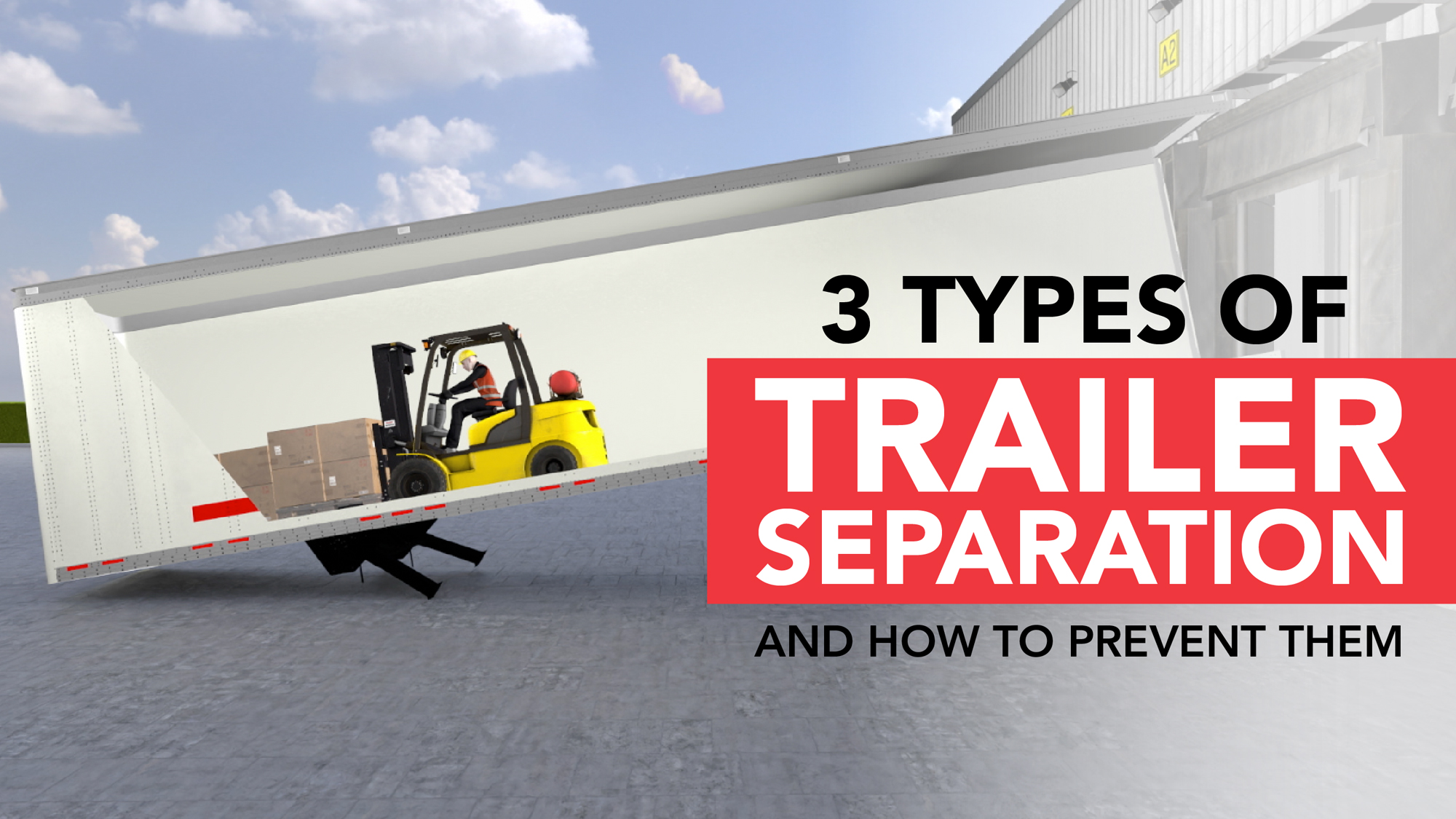03.25.2024
Trailer Separation Dangers and Prevention

There are many areas in a facility that pose the risk of injury. One of the most dangerous areas is at the loading dock. According to OSHA, 25% of all reported warehouse accidents occur at the loading dock, and for every injury, there are hundreds of near misses. With frequent traffic, large vehicles, moving machinery, and raised platforms with often-open doors, the likelihood of injury is high without proper precautions. One type of danger that is often severe or fatal but can be easily avoided is trailer separation.
Trailer separation (sometimes referred to as dock separation) occurs when a truck leaves the loading dock before loading/unloading is complete. If this happens, the separation between the truck and the building can lead to serious injury or death for the dock worker as well as damage to the forklift and cargo. There are three main types of trailer separation: premature departure, trailer creep, and landing gear collapse.
Premature Departure
The most common form of dock separation is unscheduled or premature trailer departure. In simple terms, this is either when a truck driver or spotter pull the wrong trailer away from the dock while it is being loaded/unloaded or mistakenly believe their trailer is finished being loaded/unloaded before it is. If a forklift is driving into/out of the trailer, the outcome is typically the same – bad. These are the accidents that are typically severe or fatal for obvious reasons.
Trailer Creep
The second most common type is trailer creep. Trailer creep occurs primarily as a trailer is being loaded. Typically, a forklift driver drives into the trailer at approximately 4-5 MPH. When they enter the trailer, the impact causes the trailer to slowly move forward, separating from the dock. Adding to this impact, the air ride suspension (fitted on most trailers today) allows the trailer to bounce like it is designed to cushion the ride of the load on the road. That bouncing up and down, sometimes as much as 4-6”, causes the trailer to scoot or walk away from the building. This leaves a big gap once the trailer has moved away far enough for the lip of the dock leveler to drop off of the trailer bed. This condition is compounded by the inertia of the forklift every time the driver stops (usually abruptly) in the trailer. The movement caused by the air ride suspension is also referred to as “dock walk.”
Landing Gear Collapse
The final cause for trailer separation is landing gear collapse. Landing gear are the legs that support the front of the trailer when a driver or spotter “drops” his trailer to be unloaded. If the landing gear is old or not maintained, the gearing inside can wear. That wear allows for failure and collapse of the front of the trailer. Thankfully, trailer manufacturers realized this weakness and changed the gearing to where landing gear collapse is almost unheard of today.
Trailer Restraints
To ensure the trailer stays in place during loading/unloading, a trailer restraint should be used to lock the truck in place against the building. Trailer restraints are large hooking or chocking devices that are typically operated by the dock attendant from inside the building to be sure the trailer doesn’t separate until it is safe to do so. They work by attaching to the rear impact guard (RIG), also known as ICC bar, and securing it against the building while forklift drivers or other dock workers enter and exit for loading/unloading of the trailer. Once finished and safely out of the trailer, the trailer restraint is released, and the truck is free to depart the dock.
There are three types of trailer restraints, manual (mechanical), semi-automatic, and fully automatic (electric or hydraulic). From there, the choices are just beginning. There are numerous designs such as recessed, wall mount, ground mount, wheel locking, impact, and non-impact styles, and various safety features including push button, digital human machine interface (HMI) screens for ease of operation for dock operators, LED light communication systems, and positive locking systems that communicate if the restraint is locked without having to visually inspect it.
While dock leveler features like automatic return to dock (if the trailer leaves with the lip in the back, this feature resets the leveler to its stored position automatically so there is no void in the floor) and safety velocity fuses (this limits the free fall of a dock leveler to a maximum of 3” anywhere within its operating range as the hydraulic cylinder will support the weight of the forklift if a trailer pulls out unexpectedly) may sound like enough to combat trailer separation risks, it simply is not true.
Forklift manufacturers have done studies, and we know from actual tests that if a forklift driver is driving in a trailer and recognizes the trailer is leaving, then slams on the breaks with super-human reflexes within two seconds, the forklift still travels over 14 feet. Dock levelers are typically only 8 feet long. The only way to prevent trailer separation is with a trailer restraining device.
We have been involved before and after these tragic accidents and the consensus is always the same, “We should have bought trailer restraints.” Although no conventional trailer restraint can lock all trailers, having a trailer restraint that communicates when it cannot lock is paramount to the safe and productive loading process.
Contact DH Pace for assistance selecting the right trailer restraint for your facility. Our experts have the knowledge and experience to find the best option for your application.



